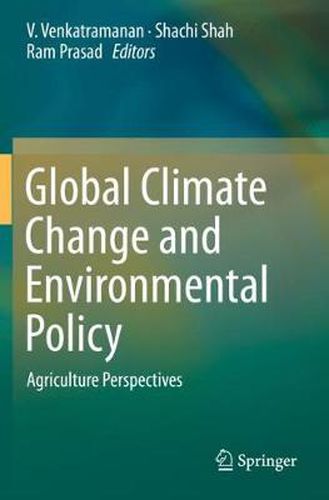Readings Newsletter
Become a Readings Member to make your shopping experience even easier.
Sign in or sign up for free!
You’re not far away from qualifying for FREE standard shipping within Australia
You’ve qualified for FREE standard shipping within Australia
The cart is loading…






This title is printed to order. This book may have been self-published. If so, we cannot guarantee the quality of the content. In the main most books will have gone through the editing process however some may not. We therefore suggest that you be aware of this before ordering this book. If in doubt check either the author or publisher’s details as we are unable to accept any returns unless they are faulty. Please contact us if you have any questions.
Global climate change threatens human existence through its potential impact on agriculture and the environment. Agriculture is climate-sensitive, and climate variability and climate change have net negative impact on it. Additionally, the agricultural landscape is affected by monoculture and agro-biodiversity loss, soil fertility depletion and soil loss, competition from biofuel production, crop yield plateaus and invasive species. Nevertheless, the global agricultural production system has to meet the food demands from the growing human population, which is set to exceed 10 billion by 2050.
This book discusses the impacts of climate change on agriculture, animal husbandry and rural livelihoods. Further, since agriculture, forestry and other land-use sectors contribute about 10-12 gigatonnes of CO2-equivalent per year, it argues that agricultural policy must dovetail adaptation and mitigation strategies to reduce greenhouse gases emissions. This calls for a reformative and disruptive agricultural strategy like climate-smart agriculture, which can operate at all spatio-temporal scales with few modifications. The book also redefines sustainable agriculture through the lens of climate-smart agriculture in the context of the sustainability of Earth’s life- support system and inter- and intra-generational equity. The climate-smart agriculture approach is gaining currency thanks to its inherent positive potential, and its goal to establish an agricultural system which includes climate-smart food systems , climate-proof farms , and climate-smart soils . Climate-smart agriculture provides a pathway to achieve sustainable development goals which focus on poverty reduction, food security, and environmental health.
$9.00 standard shipping within Australia
FREE standard shipping within Australia for orders over $100.00
Express & International shipping calculated at checkout
This title is printed to order. This book may have been self-published. If so, we cannot guarantee the quality of the content. In the main most books will have gone through the editing process however some may not. We therefore suggest that you be aware of this before ordering this book. If in doubt check either the author or publisher’s details as we are unable to accept any returns unless they are faulty. Please contact us if you have any questions.
Global climate change threatens human existence through its potential impact on agriculture and the environment. Agriculture is climate-sensitive, and climate variability and climate change have net negative impact on it. Additionally, the agricultural landscape is affected by monoculture and agro-biodiversity loss, soil fertility depletion and soil loss, competition from biofuel production, crop yield plateaus and invasive species. Nevertheless, the global agricultural production system has to meet the food demands from the growing human population, which is set to exceed 10 billion by 2050.
This book discusses the impacts of climate change on agriculture, animal husbandry and rural livelihoods. Further, since agriculture, forestry and other land-use sectors contribute about 10-12 gigatonnes of CO2-equivalent per year, it argues that agricultural policy must dovetail adaptation and mitigation strategies to reduce greenhouse gases emissions. This calls for a reformative and disruptive agricultural strategy like climate-smart agriculture, which can operate at all spatio-temporal scales with few modifications. The book also redefines sustainable agriculture through the lens of climate-smart agriculture in the context of the sustainability of Earth’s life- support system and inter- and intra-generational equity. The climate-smart agriculture approach is gaining currency thanks to its inherent positive potential, and its goal to establish an agricultural system which includes climate-smart food systems , climate-proof farms , and climate-smart soils . Climate-smart agriculture provides a pathway to achieve sustainable development goals which focus on poverty reduction, food security, and environmental health.